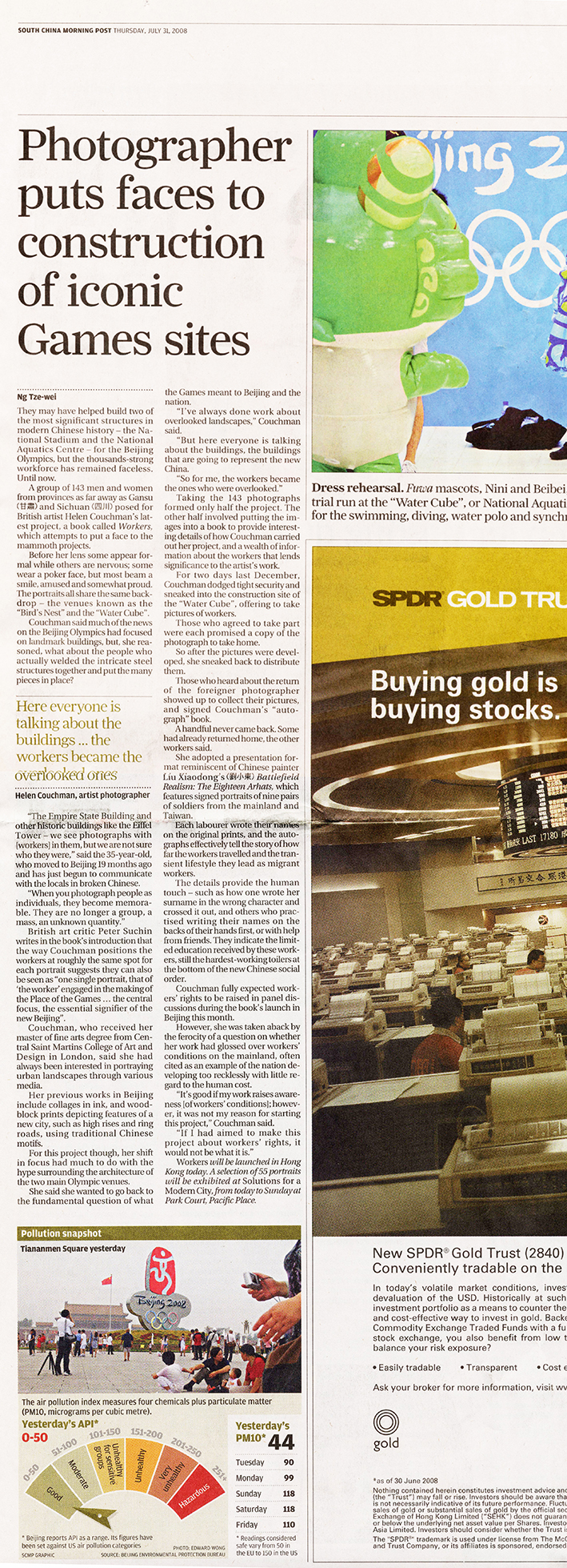WORKERS 工人 review – SCMP
Photographer puts faces to the construction of the Games sites
by Ng Tze-wei
South China Morning Post, Hong Kong, Thursday, July 31, 2008 (page 7)
They may have helped build two of the most significant structures in modern Chinese history – the National Stadium and the National Aquatics Centre – for the BJ Olympics, but the thousands-strong workforce has remained faceless. Until now.
A group of 143 men and women from provinces as far away as Gansu and Sichuan posed for British artist Helen Couchman’s latest project, a book called Workers, which attempts to put a face to the mammoth projects.
Before her lens some appear formal while others are nervous; some wear a poker face, but most beam a smile, amused and somewhat proud. The portraits all share the same backdrop – the venues known as the “Bird’s Nest” and the “Water Cube “.
Couchman said much of the news on the BJ Olympics had focused on landmark buildings, but, she reasoned, what about the people who actually welded the intricate steel structures together and put the many pieces in place?
“The Empire State Building and other historic buildings like the Eiffel Tower – we see photographs with [workers] in them, but we are not sure who they were,” said the 35-year-old, who moved to Beijing 19 months ago and has just begun to communicate with the locals in broken Chinese.
“When you photograph people as individuals, they become memorable. They are no longer a group, a mass, an unknown quantity.”
British art critic Peter Suchin writes in the book’s introduction that the way Chinese positions the workers at roughly the same spot for each portrait suggests they can also be seen as “one single portrait, that of `the worker’ engaged in the making of the Place of the Games … the central focus, the essential signifier of the new BJ”.
Couchman, who received her master of fine arts degree from Central Saint Martins College of Art and Design in London, said she had always been interested in portraying urban landscapes through various media.
Her previous works in Beijing include collages in ink, and woodblock prints depicting features of a new city, such as high rises and ring roads, using traditional Chinese motifs.
For this project though, her shift in focus had much to do with the hype surrounding the architecture of the two main Olympic venues.
She said she wanted to go back to the fundamental question of what the Games meant to BJ and the nation.
“I’ve always done work about overlooked landscapes,” Couchman said.
“But here everyone is talking about the buildings, the buildings that are going to represent the new China.
“So for me, the workers became the ones who were overlooked.”
Taking the 143 photographs formed only half the project. The other half involved putting the images into a book to provide interesting details of how Couchman carried out her project, and a wealth of information about the workers that lends significance to the artist’s work.
For two days last December, Couchman dodged tight security and sneaked into the construction site of the “Water Cube”, offering to take pictures of workers.
Those who agreed to take part were each promised a copy of the photograph to take home.
So after the pictures were developed, she sneaked back to distribute them.
Those who heard about the return of the foreigner photographer showed up to collect their pictures, and signed Couchman’s “autograph” book.
A handful never came back. Some had already returned home, the other workers said.
She adopted a presentation format reminiscent of Chinese painter Liu Xiaodong’s ‘Battlefield Realism: The Eighteen Arhats’, which features signed portraits of nine pairs of soldiers from the mainland and Taiwan.
Each labourer wrote their names on the original prints, and the autographs effectively tell the story of how far the workers travelled and the transient lifestyle they lead as migrant workers.
The details provide the human touch – such as how one wrote her surname in the wrong character and crossed it out, and others who practised writing their names on the backs of their hands first, or with help from friends. They indicate the limited education received by these workers, still the hardest-working toilers at the bottom of the new Chinese social order.
Couchman fully expected workers’ rights to be raised in panel discussions during the book’s launch in BJ this month.
However, she was taken aback by the ferocity of a question on whether her work had glossed over workers’ conditions on the mainland, often cited as an example of the nation developing too recklessly with little regard to the human cost.
“It’s good if my work raises awareness [of workers’ conditions]; however, it was not my reason for starting this project,” Couchman said.
“If I had aimed to make this project about workers’ rights, it would not be what it is.”
‘Workers’ (Gong Ren) will be launched in Hong Kong today. A selection of 55 portraits will be exhibited at ‘Solutions for a Modern City’, from today to Sunday at Park Court, Pacific Place.
